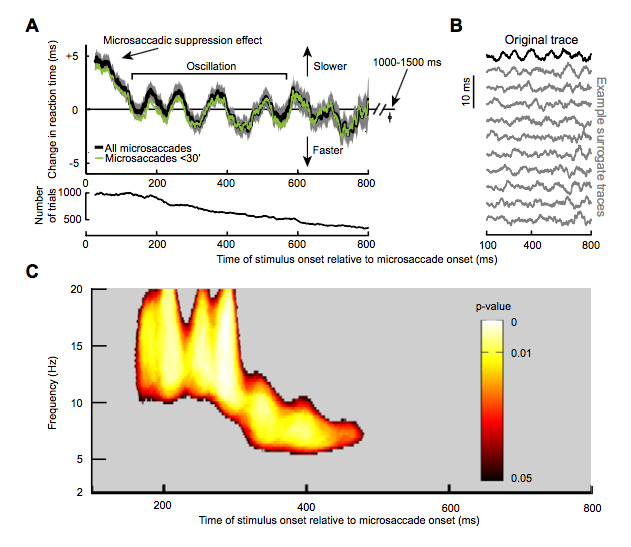We have a new exciting article in press at the Journal of Neurophysiology. In this article, we discovered an intriguing property related to microsaccades, the tiny eye movements that take place during gaze fix ation. We found that after microsaccades are generated by the oculomotor system, behavioral visual performance (e.g. stimulus detection efficiency) does not return to a stable baseline, but instead to a steady-state rhythmic oscillation in the alpha and beta frequency ranges (i.e. ~10-20 Hz).
ation. We found that after microsaccades are generated by the oculomotor system, behavioral visual performance (e.g. stimulus detection efficiency) does not return to a stable baseline, but instead to a steady-state rhythmic oscillation in the alpha and beta frequency ranges (i.e. ~10-20 Hz).
Most prior work on peri-microsaccadic influences on vision, including by our own laboratory, has focused on a short interval ~50-100 ms before or after a given movement. In this interval, phenomena like “microsaccadic suppression” (Hafed & Krauzlis, 2010; Chen et al., 2015; Chen & Hafed, 2017) are observed. However, here, we explored what happens a long time after microsaccades, and up to ~ 1 second after any given movement. We found a long-lasting impact of eye movements on visual performance.
Besides discovering steady-state oscillations after a given microsaccade, we also found that these oscillations were pulsed across visual hemifields in a sequential manner. So, for a few hundred milliseconds after a movement, the oscillation first appears in the same hemifield as the direction of a microsaccade, and then for the next few hundred milliseconds, the oscillation switches over to the opposite hemifield. This sequential pulsing is very intriguing, and one of our future objectives is to understand its functional implications.

Finally, in this same study, we found neural correlates of such long-term influences of microsaccades on visual sensitivity. We specifically found that after a short-lived “microsaccadic suppression” interval, visual sensitivity in superior colliculus neurons is actually enhanced above baseline after microsaccades.
All of these results suggest that visual processing in the brain is almost never exempt from the influences of eye movements, including tiny ones that may occur during gaze fixation. This motivates an active perception approach to studying vision, cognition, and motor control.
